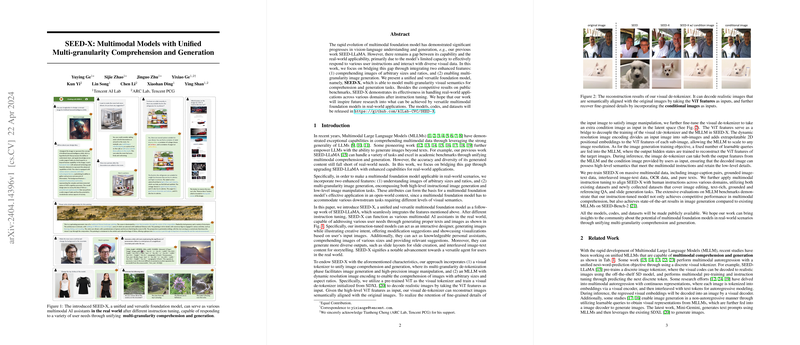Enhancing Multimodal Foundation Models for Real-world Applicability: Introducing SEED-X
Introduction to SEED-X
In the rapidly evolving domain of multimodal foundation models, the transition from laboratory settings to real-world applicability presents notable challenges, primarily due to the models' limited interaction capabilities with diverse visual and instructional data. Addressing these challenges, this paper introduces SEED-X, an enhanced version of the previously developed SEED-LLaMA. SEED-X integrates advanced features to comprehend images of arbitrary sizes and aspect ratios and enables multi-granularity image generation, ranging from high-level instructional creation to detailed image manipulation.
Key Features and Methodology
SEED-X represents a comprehensive approach to multimodal understanding and generation, designed to operate effectively in diverse real-world applications. The model architecture includes significant enhancements over its predecessors:
- Visual Tokenization and De-tokenization: Utilizes a pre-trained Vision Transformer (ViT) as a visual tokenizer coupled with a visual de-tokenizer that supports the generation of detailed images by interpreting ViT features. This setup helps in accurate image reconstruction aligned with original semantic contexts and detailed image manipulation tasks.
- Dynamic Resolution Image Encoding: Introduces a method to process images with arbitrary resolutions by employing a grid division technique for image encoding, which preserves detailed information and supports various aspect ratios without requiring standard pre-defined image sizes.
- Multimodal Pre-training and Instruction Tuning: Employs a large-scale multimodal data corpus for training, followed by instruction tuning to refine the model's capabilities to follow specific instructions in real-world applications, enhancing both comprehension and generation tasks across varied domains.
Evaluation and Performance
Extensive evaluations demonstrate SEED-X's superior performance on several benchmarks designed for multimodal LLMs. It shows competitive results in multimodal comprehension and state-of-the-art performance in image generation tasks compared to existing LLMs. Particularly, SEED-X excels in handling multi-image contexts and generating high-quality, instruction-aligned images.
Implications and Future Prospects
The development of SEED-X marks a significant step toward bridging the gap between academic multimodal model research and practical real-world applications. By enabling nuanced understanding and generation of multimodal data, SEED-X could serve various domains, from creative design to personal assistance and beyond.
Future research could explore further enhancements in the robustness of image tokenization processes and expand the model's adaptability to dynamically varied multimodal scenarios, potentially leading to more generalized AI systems capable of seamless interaction in complex real-world environments.
Conclusion
SEED-X sets a new precedent in the field of multimodal foundation models by substantially enhancing the real-world applicability of such systems. With its robust architecture and superior performance across multiple benchmarks, SEED-X not only fulfills but extends the capabilities expected of next-generation AI models, promising exciting developments in AI applications across industries.
